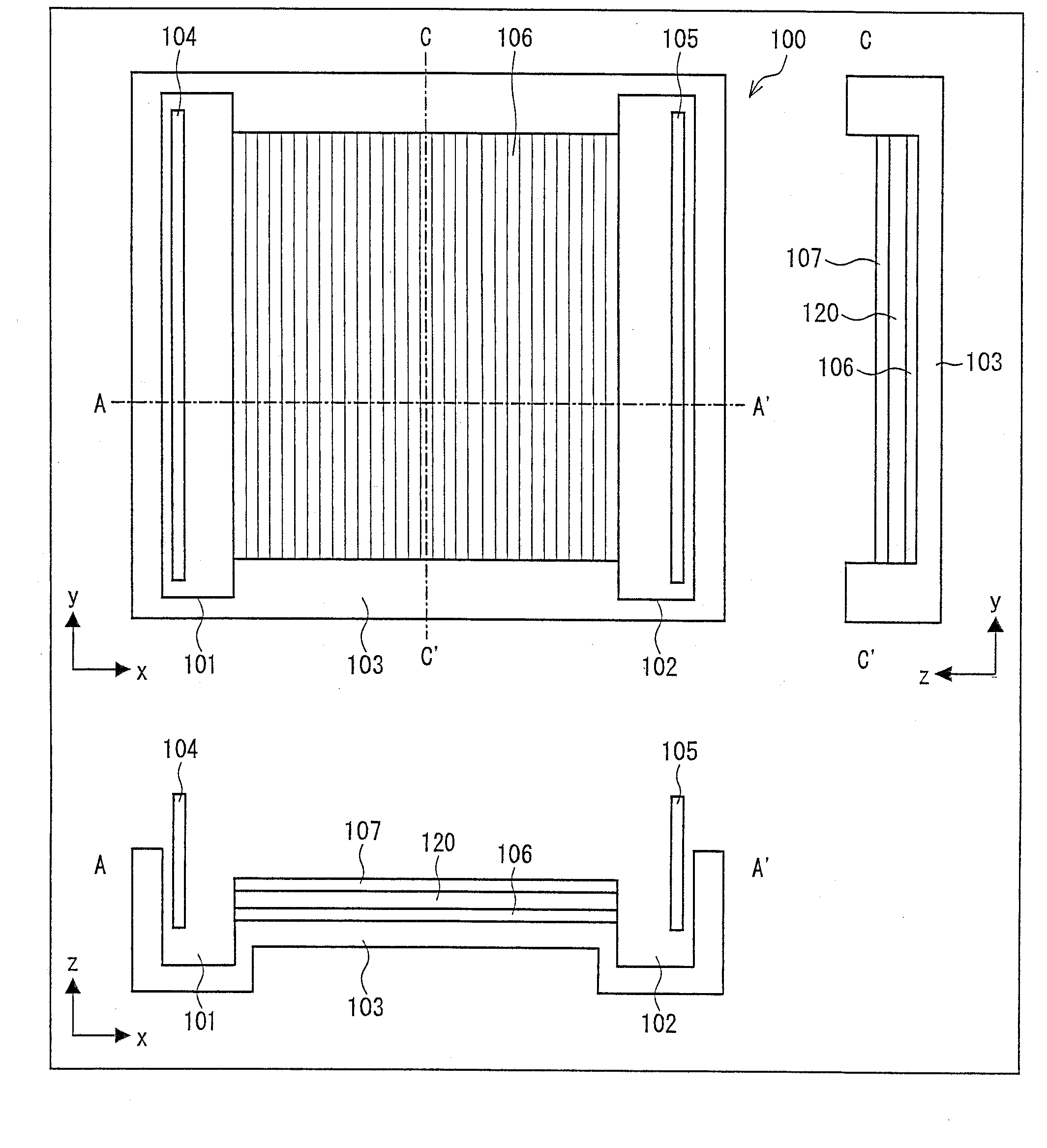Device for electrophoresis, device for transfer, device for electrophoresis and transfer, chip for electrophoresis and transfer, and method for electrophoresis, method for transfer, and method for electrophoresis and transfer
a technology which is applied in the field of electrophores methods for electrophoresis, transfer, and electrophoresis and transfer, etc., can solve the problems of electrophoresis speed decline, complex and skillful procedure, and the existence of a practical and easy-to-operate device for electrophoresis and transfer
- Summary
- Abstract
- Description
- Claims
- Application Information
AI Technical Summary
Benefits of technology
Problems solved by technology
Method used
Image
Examples
example 1
Making a Stripe Electrode
[0155]Cr binder was deposited on a 6 cm×5 cm glass plate 3 mm in thickness by a sputtering device and about 2000 Å Pt was also deposited. Then, a thickness of Pt electrode and a gap between Pt electrodes were created to be approximately 100 μm by a Dicing saw (Disco) with a blade 100 μm in thickness. In addition, two kinds of stripe electrode substrates, (i) a thickness of Pt wire and a gap between Pt wires were 100 μm and (ii) a thickness of Pt wire and a gap between Pt wires were 50 μm, were created by a CO2 laser carving machine under a following cutting condition, laser power 7%, process speed 6%, and 3000 Hz (FIG. 6). Note that the surface of the glass was little processed by a laser under the above condition.
example 2
Comparison of Substrates
[0156]A pair of 6 cm×5 cm gel plates (glass plate) sandwiching 1 mm spacer therebetween was placed in a gel-making container. A glass substrate was used as one side of the gel plates. As for the other side of the gel plates, a stripe electrode substrate plate in which a thickness of Pt wire and a gap between Pt wires were 100 μm, a substrate whose entire surface was covered by Pt, or a glass substrate (positive control) was used.
[0157]Next, after adding a processed resolving gel solution (13% acrylamide mixture (acrylamide:bisacrylamide=29.2:0.8), 378 mM Tris-HCl (pH 8.8), 0.05% APS, and 0.1% TEMED) up to 7 mm from the tip, water was added to form a water layer thereon. After the polymerization of the resolving gel solution, the water was removed, and then the processed and concentrated resolving gel solution (4% acrylamide mixture (acrylamide:bisacrylamide=29.2:0.8), 125 mM Tris-HCl (pH 8.8), 0.05% APS, and 0.2% TEMED) was added. Then, a sample comb was plac...
example 3
Studying a Method for Preventing the Generation of Air Bubbles
[0162]It was deduced that water electrolysis might occur between a pair of electrodes due to a potential difference between the electrodes (wires) of the stripe electrodes, thereby causing the air bubbles. Then, it was predicted that the generation of air bubbles could be prevented by controlling the potential difference between each pair of electrodes below 1V, decomposition voltage of water.
[0163]Then, with use of a stripe electrode substrate in which the thickness of Pt wire and the gap between Pt wires were 100 μm, the generation of air bubbles was monitored when altering applied voltage during SDS-PAGE. Table 1 shows the applied voltages, and calculated voltages between each pair of electrodes when the applied voltages were applied. Note that a voltage between a pair of electrodes was calculated by an applied voltage divided by the number of stripes.
TABLE 1VoltagebetweenTheeach pairNumberInitialDevice forofofElectric...
PUM
| Property | Measurement | Unit |
|---|---|---|
| voltage | aaaaa | aaaaa |
| voltage | aaaaa | aaaaa |
| voltage | aaaaa | aaaaa |
Abstract
Description
Claims
Application Information
 Login to View More
Login to View More - R&D
- Intellectual Property
- Life Sciences
- Materials
- Tech Scout
- Unparalleled Data Quality
- Higher Quality Content
- 60% Fewer Hallucinations
Browse by: Latest US Patents, China's latest patents, Technical Efficacy Thesaurus, Application Domain, Technology Topic, Popular Technical Reports.
© 2025 PatSnap. All rights reserved.Legal|Privacy policy|Modern Slavery Act Transparency Statement|Sitemap|About US| Contact US: help@patsnap.com



